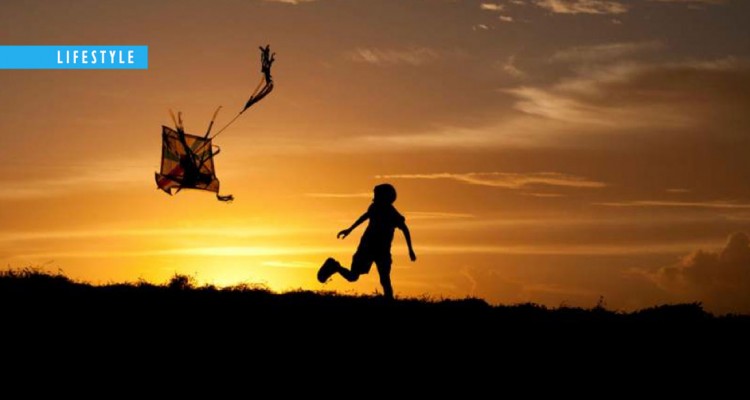Let the chorus soar…
On Makar Sankranti day in January, Ahmedabad’s skyline turns colourful with the young and the old, the kakas and the kakis, the bhais and the bens, and the chhoras and the chhoris, all tugging at the strings and the kites soaring and floating around. But that’s just once a year…
Here in Lucknow, patangbaazi (kite- flying) is a fun way to prove one’s finesse and skills at pench ladaoing, be it summer or winter, spring or autumn.
Most of all the recreations or sporting activities indulged in by the Nawabs in their days of glory have ceased to exist, except a couple of them, kabootarbaazi (pigeon racing) and patangbaazi.
The Nawabs spent most of their time in sports that were typically of Lucknawi andaaz. For instance, they organised combat between predatory birds. However, the interest in watching combats gradually began to wane as it was an expensive affair and the comman man could not afford it. With the passage of time, bird fighting, pigeon racing, shatranj (chess) and kite flying gained popularity.
Since kite flying was not an expensive sport and could be afforded by all the strata of people, its popularity increased and the Nawabs promoted the art of kite flying and soon competitions began to be held under their patronage.
A visit to the old city, be it Chowk, Chaupatiyon, Nakkhas or Nazirabad, one would come across kite flying enthusiasts who are ready to take on their rivals in the skies with their addhis, paunas, pauntais (named after the size of kites), manjha,saddi and charkha.
“Woh Kaata” reverberates across the localities as chaps, maangdars and taukhias (designs of kites) battle it out in the air. And then there are those who go out in the field armed with langad (sling) and stick and enjoy the fun of patang lootna and manjha lootna.
Though there is no credible evidence to suggest the origins of patangbaazi in India, it is believed the sport arrived during the reign of Mughal king Shah Alam I, basically as a night sport in the form of tikoni qandeel (prismatic candle). Tikoni qandeel further took the shape of human effigies or putla and then to chhang which was quadrangular in shape and designed on the pattern of the legendary ‘Akashdiya’ of Indian mythology. Further, for the purpose of day light flying, modified version of chhang known as Tikkal (in local language), decorated with fringes of silver and gold came in to being. Tikkal was as such chhang was cut into half. Tikkal was further improved and given the shape of the present day patang.
The main components of a kite are chips of bamboo, paper and ghul. When in the year 1775, Nawab Asaf-ud-daula shifted his capital from Faizabad to Lucknow, many artisans, craftmen, sportsmen excelling in their respective fields also shifted to Lucknow. Among them were also some reputed patangbaaz from Delhi who introduced pench ladana to Lucknowites and thereby reel and charkha/charkhi were introduced. Charkhi is a cylindrical device made up of wood and bamboo sticks on which the dore (reel) is wrapped. Dore (reel) is made sharp by application of powdered glass and crushed boiled rice.
It is also said that Nawab Asaf-ud-daula himself was an accomplished patanbaaz. The royal patang that he used was different from normal as it had a plume of gold and silver ribbons and whosoever manage to grab the royal patang was at liberty to return it to the palace and get a financial reward of five rupees or sell in the open market at his desired price.
During the tenure of Nawab Asaf-ud- daula a patangbaaz who could cut nine consecutive pench with one kite was declared Nausherwan and was richly rewarded. In major tournaments, the rival teams flew sunehri (golden) and rupahali (silver) kites tied to sunehri and rupahali dores.
A new type of kite called Guddi, which was rhombic in shape, was introduced during the tenure of Nawab Amjad Ali Shah Bahadur.
As a legend related to Nawab Wajid Ali Shah goes, there was a drought during his time and people were dying. Since he did not know what to do, he started a novel way of doling out largesse. Small quantities of gold, silver or currency notes were tied with the kite and flown. When the dore snapped the kite would ␣oat in the air and begin its descent. On the ground, any person who laid his/her hand on that kite did not have to bother about the day’s meals.
During Wajid Ali Shah’s time, further changes were made in the designs and so emerged the derh kanna (1 1⁄2 kanna) kan kauwwa, which had a paper phunna (plume) later substituted by patta (leaf ). Designed by Ustad Agha Abu Tarab Khan, Muhammad Hussain and others, kankauwwa with a patta is in vogue till date.
In the olden days, kites were also used namabar (postman) for lovers to deliver love letters to their beloved residing at a distance. The utility of kites for lovebirds has best been described in florid urdu in Masnavi-e-Zahr-e-Ishq by Nawab Mirza Shauq, one of the poets in the court of Nawab Wajid Ali Shah.
In Nawab Wajid Ali Shah’s time, dheel (loosening of the dore) was practised in patangbaazi and the pench (combat) based on this was known as lambadora (lambi dore ka pench). Later, this technique gave way to kheench (fast pulling of the dore). Modern Patangbaazi is based on this technique.
The abolition of zamindari and taluqdari systems in 1952 dealt a harsh blow to the Nawabs and their pastimes of all types like baterbazi and murghbaazi faded into oblivion. Patangbaazi, due to its popularity among the masses combined with its low cost, managed to survive and even flourish.
In the good old days Sheikh Imdad, Mir Amdu and Khwaja Mathan were famous far and wide while in the post-Nawabi era Elahi Baksh Tundey and Mir Vilayat Ali had earned the name in this field.
The most important day of the year for kite flying is jamghat, which comes after Diwali. Kite flyers go on one round after another to outsmart and outshine their rivals throughout the day.
To preserve our cultural heritage, we the citizens of Lucknow should make efforts that with the digital advancement and crass commercialization, the patangbazi culture of Lucknow not only exists but also flourishes.

